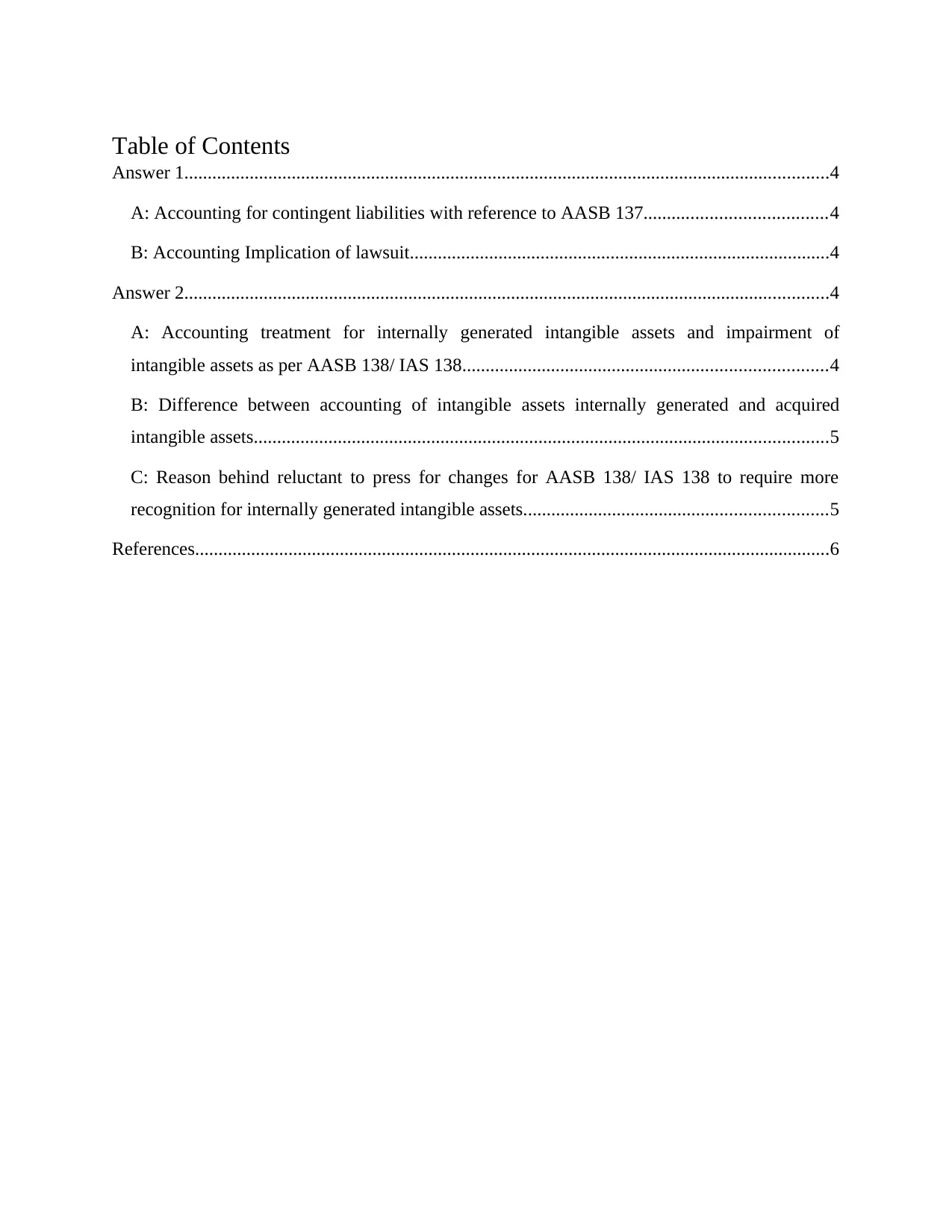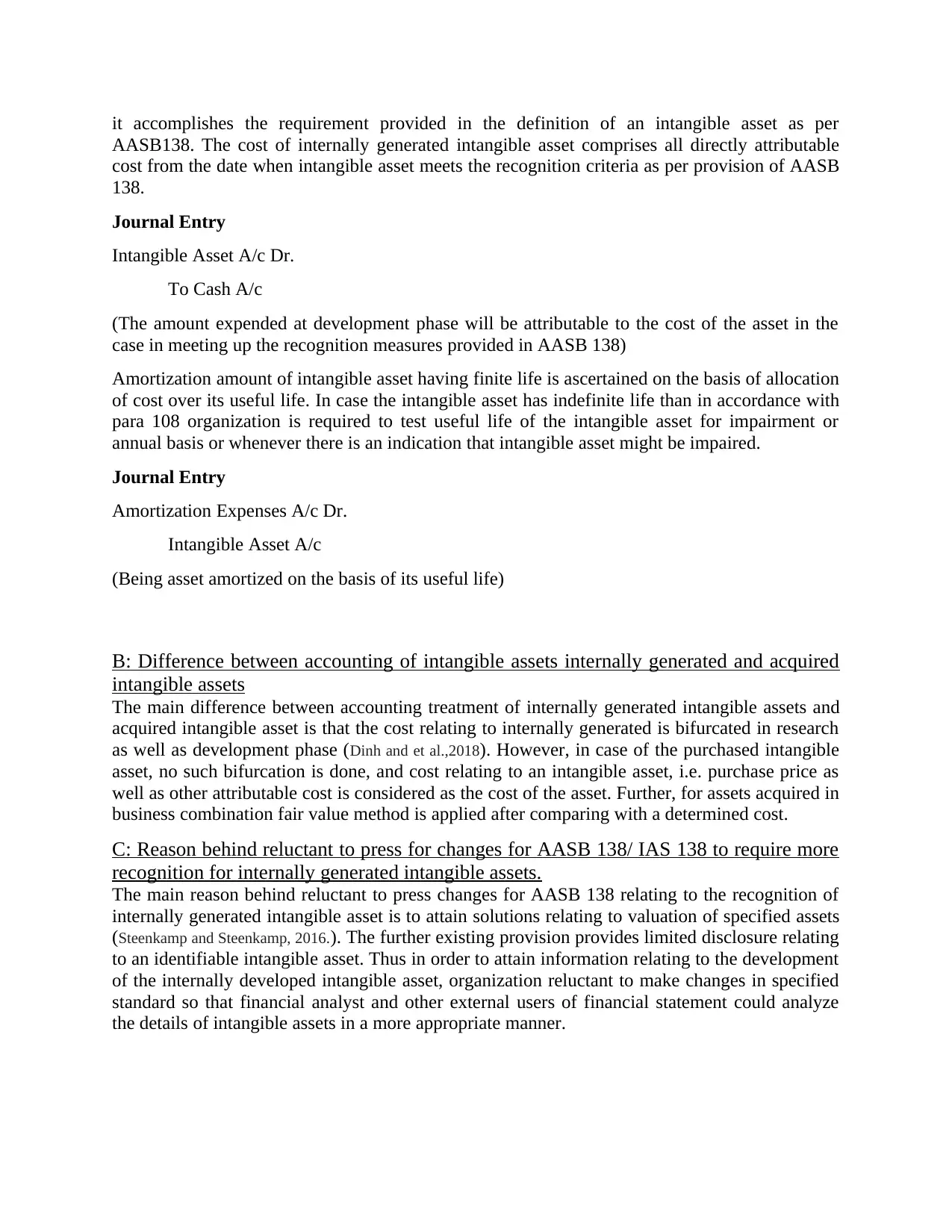ACC201: Financial Accounting Report - Delta Ltd Lawsuit Analysis
VerifiedAdded on 2023/03/31
|6
|1206
|262
Report
AI Summary
This financial accounting report addresses two key areas: contingent liabilities and intangible assets, referencing the relevant Australian Accounting Standards (AASB). The first part analyzes a lawsuit filed against Delta Ltd, applying AASB 137 to determine the appropriate accounting treatment and disclosure requirements for the contingent liability. It considers the probability of the lawsuit's outcome and the potential financial implications. The second part of the report focuses on intangible assets, specifically addressing the accounting treatment for internally generated intangible assets and impairment, as per AASB 138. It differentiates between internally generated and acquired intangible assets, explores the reasons behind the reluctance to change AASB 138 regarding the recognition of internally generated assets, and provides relevant journal entries. The report provides a comprehensive overview of the accounting standards and their practical application.

FINANCIAL ACCOUNTING
Paraphrase This Document
Need a fresh take? Get an instant paraphrase of this document with our AI Paraphraser

Executive Summary
Financial reporting refers to disclosure of financial results as well as related information to the
users of financial statements relating to operations of an organization over a specific period of
time. The present report provides disclosure requirement relating to contingent liabilities as well
as an intangible asset. It has been accessed that an organization does not require to recognize a
contingent liability. Further, in the case of intangible asset, an organization require to provide
disclosure in accordance with provision specified in AASB 138.
Financial reporting refers to disclosure of financial results as well as related information to the
users of financial statements relating to operations of an organization over a specific period of
time. The present report provides disclosure requirement relating to contingent liabilities as well
as an intangible asset. It has been accessed that an organization does not require to recognize a
contingent liability. Further, in the case of intangible asset, an organization require to provide
disclosure in accordance with provision specified in AASB 138.

Table of Contents
Answer 1..........................................................................................................................................4
A: Accounting for contingent liabilities with reference to AASB 137.......................................4
B: Accounting Implication of lawsuit..........................................................................................4
Answer 2..........................................................................................................................................4
A: Accounting treatment for internally generated intangible assets and impairment of
intangible assets as per AASB 138/ IAS 138..............................................................................4
B: Difference between accounting of intangible assets internally generated and acquired
intangible assets...........................................................................................................................5
C: Reason behind reluctant to press for changes for AASB 138/ IAS 138 to require more
recognition for internally generated intangible assets.................................................................5
References........................................................................................................................................6
Answer 1..........................................................................................................................................4
A: Accounting for contingent liabilities with reference to AASB 137.......................................4
B: Accounting Implication of lawsuit..........................................................................................4
Answer 2..........................................................................................................................................4
A: Accounting treatment for internally generated intangible assets and impairment of
intangible assets as per AASB 138/ IAS 138..............................................................................4
B: Difference between accounting of intangible assets internally generated and acquired
intangible assets...........................................................................................................................5
C: Reason behind reluctant to press for changes for AASB 138/ IAS 138 to require more
recognition for internally generated intangible assets.................................................................5
References........................................................................................................................................6
⊘ This is a preview!⊘
Do you want full access?
Subscribe today to unlock all pages.

Trusted by 1+ million students worldwide

ANSWER 1
A: Accounting for contingent liabilities with reference to AASB 137
In accordance with the definition provided in AASB 137, a contingent liability is a possible
obligation which arises from a past event and can be confirmed on the basis of occurrence or
non-occurrence of an event in future which is not in control of the entity (Castilla-Polo and
Gallardo-Vázquez, 2016). Further, if any liability is not recognized as it has arisen from the past
event but the amount of obligation cannot be ascertained in a reliable manner, or significant
probability does not exist regarding outflow of resources. The accounting treatment of contingent
liabilities has been specified in para 27 to para 30 of AASB 137. The specified para asserts that
an organization shall not recognize a contingent liability. Moreover, the part of obligation which
is expected to meet by other parties is treated as a contingent liability. As per para 86 of AASB
137, an organization is required to disclose contingent liability unless the probability of outflow
is remote (AASB 137 Provisions, Contingent Liabilities and Contingent Assets. 2018).
B: Accounting Implication of lawsuit
In the present case, as the probability of chances of winning of the customer is extortionate and
Delta is having significant chances of winning. Thus, as per the provisions of AASB 137 as the
probability of outflow of economic benefit is remote, the claim of $3 million will not be
disclosed in books of account. Further disclosure relating to expected liability relating to
damages, i.e. $ 500000, will be provided in notes to accounts.
Notes to accounts of Delta Ltd:
Contingent liability of $500000 does exist relating to cost and damages relating to a lawsuit
made against the company. However, the probability of winning the customer is remote.
ANSWER 2
A: Accounting treatment for internally generated intangible assets and impairment of
intangible assets as per AASB 138/ IAS 138
In accordance of para 21 of AASB 138, an intangible asset is recognized only in case it is
probable that expected future economic benefit relating to the asset will be attained by the
organization and the cost of assets can be evaluated in a reliable manner (Kabir and Rahman, 2016).
It has been stated in para 48 of AASB 138 that internally generated goodwill will not be
recognized as an asset. Further, internally generated intangible assets will be recognized in
accordance with the provision relating to the classification of assets into the research phase and
development phase. The cost of internally generated intangible asset comprises the cost of
material and services attributable to generating intangible asset (AASB 138 Intangible Assets,
2018). Expenses relating to employee benefits, legal expenses as well as other direct attributable
cost is considered while evaluating the cost of an intangible asset. Further, selling and
administrative expenses, training expenses and initial operating loss are not considered as part of
the cost of an intangible asset. No intangible asset arising from the research phase and
expenditure relating to the research phase in recognized as an expense when incurred. An
intangible asset resulting from the development phase is recognized as an intangible asset only if
A: Accounting for contingent liabilities with reference to AASB 137
In accordance with the definition provided in AASB 137, a contingent liability is a possible
obligation which arises from a past event and can be confirmed on the basis of occurrence or
non-occurrence of an event in future which is not in control of the entity (Castilla-Polo and
Gallardo-Vázquez, 2016). Further, if any liability is not recognized as it has arisen from the past
event but the amount of obligation cannot be ascertained in a reliable manner, or significant
probability does not exist regarding outflow of resources. The accounting treatment of contingent
liabilities has been specified in para 27 to para 30 of AASB 137. The specified para asserts that
an organization shall not recognize a contingent liability. Moreover, the part of obligation which
is expected to meet by other parties is treated as a contingent liability. As per para 86 of AASB
137, an organization is required to disclose contingent liability unless the probability of outflow
is remote (AASB 137 Provisions, Contingent Liabilities and Contingent Assets. 2018).
B: Accounting Implication of lawsuit
In the present case, as the probability of chances of winning of the customer is extortionate and
Delta is having significant chances of winning. Thus, as per the provisions of AASB 137 as the
probability of outflow of economic benefit is remote, the claim of $3 million will not be
disclosed in books of account. Further disclosure relating to expected liability relating to
damages, i.e. $ 500000, will be provided in notes to accounts.
Notes to accounts of Delta Ltd:
Contingent liability of $500000 does exist relating to cost and damages relating to a lawsuit
made against the company. However, the probability of winning the customer is remote.
ANSWER 2
A: Accounting treatment for internally generated intangible assets and impairment of
intangible assets as per AASB 138/ IAS 138
In accordance of para 21 of AASB 138, an intangible asset is recognized only in case it is
probable that expected future economic benefit relating to the asset will be attained by the
organization and the cost of assets can be evaluated in a reliable manner (Kabir and Rahman, 2016).
It has been stated in para 48 of AASB 138 that internally generated goodwill will not be
recognized as an asset. Further, internally generated intangible assets will be recognized in
accordance with the provision relating to the classification of assets into the research phase and
development phase. The cost of internally generated intangible asset comprises the cost of
material and services attributable to generating intangible asset (AASB 138 Intangible Assets,
2018). Expenses relating to employee benefits, legal expenses as well as other direct attributable
cost is considered while evaluating the cost of an intangible asset. Further, selling and
administrative expenses, training expenses and initial operating loss are not considered as part of
the cost of an intangible asset. No intangible asset arising from the research phase and
expenditure relating to the research phase in recognized as an expense when incurred. An
intangible asset resulting from the development phase is recognized as an intangible asset only if
Paraphrase This Document
Need a fresh take? Get an instant paraphrase of this document with our AI Paraphraser

it accomplishes the requirement provided in the definition of an intangible asset as per
AASB138. The cost of internally generated intangible asset comprises all directly attributable
cost from the date when intangible asset meets the recognition criteria as per provision of AASB
138.
Journal Entry
Intangible Asset A/c Dr.
To Cash A/c
(The amount expended at development phase will be attributable to the cost of the asset in the
case in meeting up the recognition measures provided in AASB 138)
Amortization amount of intangible asset having finite life is ascertained on the basis of allocation
of cost over its useful life. In case the intangible asset has indefinite life than in accordance with
para 108 organization is required to test useful life of the intangible asset for impairment or
annual basis or whenever there is an indication that intangible asset might be impaired.
Journal Entry
Amortization Expenses A/c Dr.
Intangible Asset A/c
(Being asset amortized on the basis of its useful life)
B: Difference between accounting of intangible assets internally generated and acquired
intangible assets
The main difference between accounting treatment of internally generated intangible assets and
acquired intangible asset is that the cost relating to internally generated is bifurcated in research
as well as development phase (Dinh and et al.,2018). However, in case of the purchased intangible
asset, no such bifurcation is done, and cost relating to an intangible asset, i.e. purchase price as
well as other attributable cost is considered as the cost of the asset. Further, for assets acquired in
business combination fair value method is applied after comparing with a determined cost.
C: Reason behind reluctant to press for changes for AASB 138/ IAS 138 to require more
recognition for internally generated intangible assets.
The main reason behind reluctant to press changes for AASB 138 relating to the recognition of
internally generated intangible asset is to attain solutions relating to valuation of specified assets
(Steenkamp and Steenkamp, 2016.). The further existing provision provides limited disclosure relating
to an identifiable intangible asset. Thus in order to attain information relating to the development
of the internally developed intangible asset, organization reluctant to make changes in specified
standard so that financial analyst and other external users of financial statement could analyze
the details of intangible assets in a more appropriate manner.
AASB138. The cost of internally generated intangible asset comprises all directly attributable
cost from the date when intangible asset meets the recognition criteria as per provision of AASB
138.
Journal Entry
Intangible Asset A/c Dr.
To Cash A/c
(The amount expended at development phase will be attributable to the cost of the asset in the
case in meeting up the recognition measures provided in AASB 138)
Amortization amount of intangible asset having finite life is ascertained on the basis of allocation
of cost over its useful life. In case the intangible asset has indefinite life than in accordance with
para 108 organization is required to test useful life of the intangible asset for impairment or
annual basis or whenever there is an indication that intangible asset might be impaired.
Journal Entry
Amortization Expenses A/c Dr.
Intangible Asset A/c
(Being asset amortized on the basis of its useful life)
B: Difference between accounting of intangible assets internally generated and acquired
intangible assets
The main difference between accounting treatment of internally generated intangible assets and
acquired intangible asset is that the cost relating to internally generated is bifurcated in research
as well as development phase (Dinh and et al.,2018). However, in case of the purchased intangible
asset, no such bifurcation is done, and cost relating to an intangible asset, i.e. purchase price as
well as other attributable cost is considered as the cost of the asset. Further, for assets acquired in
business combination fair value method is applied after comparing with a determined cost.
C: Reason behind reluctant to press for changes for AASB 138/ IAS 138 to require more
recognition for internally generated intangible assets.
The main reason behind reluctant to press changes for AASB 138 relating to the recognition of
internally generated intangible asset is to attain solutions relating to valuation of specified assets
(Steenkamp and Steenkamp, 2016.). The further existing provision provides limited disclosure relating
to an identifiable intangible asset. Thus in order to attain information relating to the development
of the internally developed intangible asset, organization reluctant to make changes in specified
standard so that financial analyst and other external users of financial statement could analyze
the details of intangible assets in a more appropriate manner.

REFERENCES
AASB 137 Provisions, Contingent Liabilities and Contingent Assets. 2018.(Online). Available
through < https://www.aasb.gov.au/admin/file/content105/c9/AASB137_07-
04_COMPjun14_04-14.pdf [Accessed on 26th May 2019]
AASB 138 Intangible Assets. 2018.(Online). Available through <
https://www.aasb.gov.au/admin/file/content105/c9/AASB138_08-15_COMPoct15_01-18.pdf>.
[Accessed on 26th May 2019]
Castilla-Polo, F. and Gallardo-Vázquez, D., 2016. The main topics of research on disclosures of intangible assets: a
critical review. Accounting, Auditing & Accountability Journal, 29(2), pp.323-356.
Dinh, T., Kang, H., Morris, R.D. and Schultze, W., 2018. Evolution of intangible asset accounting: Evidence from
Australia. Journal of International Financial Management & Accounting, 29(3), pp.247-279.
Kabir, H. and Rahman, A., 2016. The role of corporate governance in accounting discretion under IFRS: Goodwill
impairment in Australia. Journal of Contemporary Accounting & Economics, 12(3), pp.290-308.
Steenkamp, N. and Steenkamp, S., 2016. AASB 138: a catalyst for managerial decisions reducing R&D
spending?. Journal of Financial Reporting and Accounting, 14(1), pp.116-130.
AASB 137 Provisions, Contingent Liabilities and Contingent Assets. 2018.(Online). Available
through < https://www.aasb.gov.au/admin/file/content105/c9/AASB137_07-
04_COMPjun14_04-14.pdf [Accessed on 26th May 2019]
AASB 138 Intangible Assets. 2018.(Online). Available through <
https://www.aasb.gov.au/admin/file/content105/c9/AASB138_08-15_COMPoct15_01-18.pdf>.
[Accessed on 26th May 2019]
Castilla-Polo, F. and Gallardo-Vázquez, D., 2016. The main topics of research on disclosures of intangible assets: a
critical review. Accounting, Auditing & Accountability Journal, 29(2), pp.323-356.
Dinh, T., Kang, H., Morris, R.D. and Schultze, W., 2018. Evolution of intangible asset accounting: Evidence from
Australia. Journal of International Financial Management & Accounting, 29(3), pp.247-279.
Kabir, H. and Rahman, A., 2016. The role of corporate governance in accounting discretion under IFRS: Goodwill
impairment in Australia. Journal of Contemporary Accounting & Economics, 12(3), pp.290-308.
Steenkamp, N. and Steenkamp, S., 2016. AASB 138: a catalyst for managerial decisions reducing R&D
spending?. Journal of Financial Reporting and Accounting, 14(1), pp.116-130.
⊘ This is a preview!⊘
Do you want full access?
Subscribe today to unlock all pages.

Trusted by 1+ million students worldwide
1 out of 6
Related Documents
Your All-in-One AI-Powered Toolkit for Academic Success.
+13062052269
info@desklib.com
Available 24*7 on WhatsApp / Email
![[object Object]](/_next/static/media/star-bottom.7253800d.svg)
Unlock your academic potential
Copyright © 2020–2025 A2Z Services. All Rights Reserved. Developed and managed by ZUCOL.





